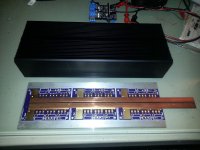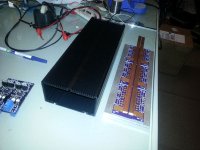Here is what my new controller is going to look like. I have all the parts but still need to finish the design of the brain board. This should do 300A phase and I think I can safely push it to 333A, 111A per MOSFET since I am matching them. This version should be a lot more fun with my high speed Cromotor in the videos I'm making. With a regular Cromotor the 200A controller should be plenty. I'm going to switch to my 16" rim with a normal Cromotor this weekend and give it a test using the same 100V battery pack and current settings. More videos to come.
View attachment 1
One thing I have noticed using this controller vs the typical Xie Chang controllers is how much better the throttle control on this one is. The Xie Chang controllers certainly have more initial punch off the line, but that's because they tend to over shoot the current. The EB3 controllers have less punch than the EB2s do since they appear to do a better job at limiting current. If I set my 24 MOSFET Xie Chang controller to 150A battery, 200A phase and use the same battery pack, it will have faster acceleration and more punch off the line than this controller. That's because it's overshooting the current. After feeling the difference I'm guessing it's overshooting the current by quite a large amount. It's no surprise to me that the cheap Chinese controllers can die sudden and sometimes violent deaths when pushed hard now that I feel the difference with real phase current limiting.
Here is some more video of my riding around on this controller with a 100V 18AH battery pack. Settings are 225A phase (I'm pushing the sensors beyond their 200a limit but still just barely in range based on what I saw from my scope when bench testing them), 150A battery current. I need to switch to some higher current sensors if I want to really push the limits of this controller and see just how high it can go with 4 paralleled MOSFETs, but the reality is 200A should be a safe number from what I'm seeing temperature wise. Max speed recorded in this video was 51mph on GPS which is as fast as it will go on a 75V pack. I need more road since I don't have enough current to accelerate me faster.
Good news is I ran the 100V pack for several miles of abuse and didn't have any faults, so initially it looks like my gate driver / power stage design is pretty stable. It needs more testing, but this is very promising, especially since my MOSFET case temps are staying low, 60C was the hottest temp I could get it to directly on the MOSFET tab.



